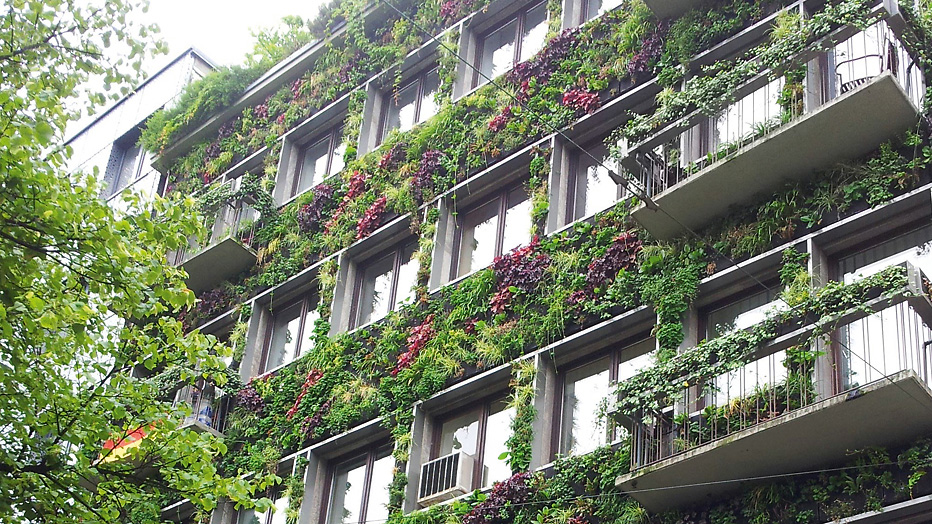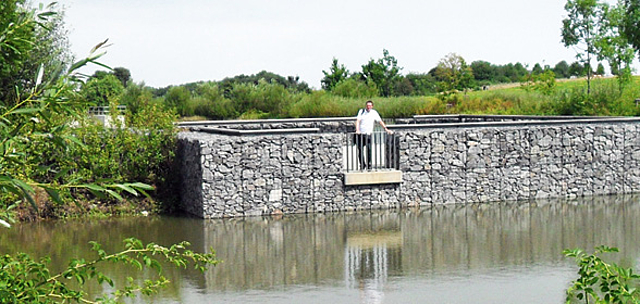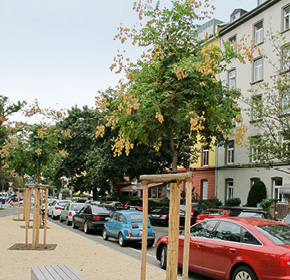Project Profile
Project Title: „Frankfurt‘s adaptation strategy for climate change
Subject Cluster: Climate Protection and Open Spaces
Project Objectives: Adapting the city to meet the impact of climate change.
Project Start: 2008
Project Participants: Coordination group Climate Change (KGK), ¬overall responsibility: Department of Environment and Health
More heat and summer droughts, more frequent downpours and storms, more severe flooding in winter: climate change will also affect life in Frankfurt. The adaptation strategy outlines objectives, guidelines and measures for keeping the city liveable.
Climate change will not only lead to rising average temperatures, but also to more frequent weather extremes. Frankfurt is actively combatting this, not only with projects and a series of networks related to climate protection but is also developing precautionary measures for adapting to the, now inevitable, consequences of climate change. The Climate Change Coordination Group (KGK), composed of specialists from eleven agencies and Departments in the city administration, developed a strategy to adapt to climate change. This was agreed upon by the City Council in September 2014.
Including climate change in all planning
The adaptation strategy describes the status quo in the city and the consequences of climate change which are already apparent today. Perspectives, goals and proposed measures are outlined for planning, construction, green, mobility, water and health. The adaptation strategy serves as orientation which must still be specified and adapted to changing conditions.
Scientific assessment of hotspots and cool air channels
A model project with the German Weather Service (DWD) projects global and regional climate forecasts to the scale of the city and shows where the core areas of climate change will be in Frankfurt. The Climate Plan Atlas, which was compiled in conjunction with the University of Kassel, gives more data relating to the city climate. It shows which zones have thermal deficits („Hotspots“), in which areas cool and cold air is produced and which „air channels“ must always be kept free so cooling air flows can reach the city at night. The atlas is to be developed so that sensitive areas are recognisable at district level and concrete improvement schemes planned, such as greening or de-sealing. Further economic growth and a growing population confront urban planning with the challenge of restricting over-warming tendencies as far as possible, regardless of necessary new building development and of keeping land usage to a minimum. Cold-air corridors would be registered and secured in zoning and development planning.
Keeping more frequent storms and floods in mind
More frequent and heavier rainfall can lead to a breakdown of the urban infrastructure and cause serious damage. Flood protection is currently being updated with the“ Flood Management Concept Main“. Together with the neighbouring communities, water levels and early-warning systems have been established for the streams in Taunus.
Leaflets published in ten languages and sent to the residents along the rivers and streams, provide information about the risks and preventive measures against flooding after heavy rain. Further measures will improve the water quality in dry periods and aid the recharge of groundwater. Rain water management schemes in new residential areas and de-sealing in existing areas will e.g. allow more rainwater to drain away directly.
Making buildings fit for climate change
Building construction goes hand in hand with climate protection, climate adjustment and residential comfort. Good insulation improves energy efficiency and the indoor climate and, with sun protection and night ventilation, makes the installation of air conditioning unnecessary. Greened roofs and facades also help the urban climate and should be sponsored. A handbook informs owner builders in the city which precautions they can take against heat and floods. Other topics are energy efficiency, rainwater management and the protection of the tree population and biotopes.
Preserving green spaces
Climate-impacting green spaces such as parks, green corridors and avenues should be preserved and linked wherever possible, with the aim of creating green „spokes“ from the city centre to the Green Belt and „rays“ out into the surrounding areas.
„The Frankfurt Tree List“ provides tips as to which trees should be given preference when re-planting city streets. New, and a greater variety of, species make the tree population more resistant.
Health for every section of the population
The Public Health Department issues an alert in accordance with a heat warning system to sensitive areas such as hospitals and nursing facilities. Besides the prevention of heat-related illnesses, a study is being conducted into the impact on human health of climate-induced change in plants (e.g. allergy risks) and animals (e.g. risk of infection).

Planning
Orientation for planning, construction, green, mobility, water and health; scientific research into core areas of climatic stress in the city; planning of targeted improvement measures.

Weather extremes
Softening the after-effects by greening and protecting cold-air corridors; rainwater management; preventing damage from flooding and heat, e.g. flood control, sun protection measures.

Health
Ensuring the amenity value in buildings and public spaces; heat warning system for sensitive areas; preventing heat-related illnesses, allergies and infections.
Environment Department
Hans-Georg Dannert
Tel +49 (0)69 212-39476
hans-georg.dannert(at)stadt-frankfurt.de



